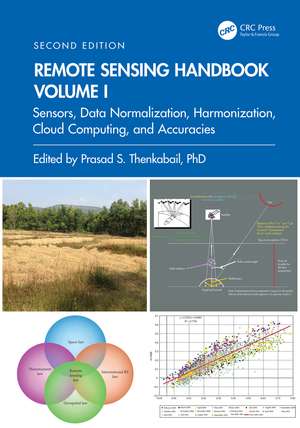Remote Sensing Handbook, Volume I: Sensors, Data Normalization, Harmonization, Cloud Computing, and Accuracies: Remote Sensing Handbook
Editat de Prasad S. Thenkabailen Limba Engleză Hardback – 29 noi 2024
FEATURES
- Provides the most up-to-date comprehensive coverage of remote sensing science.
- Discusses and analyzes data from old and new generations of satellites and sensors.
- Provides comprehensive methods and approaches for remote sensing data normalization, standardization, and harmonization.
- Includes numerous case studies on advances and applications at local, regional, and global scales.
- Introduces advanced methods in remote sensing such as machine learning, cloud computing, and AI.
- Highlights scientific achievements over the last decade and provides guidance for future developments.
Preț: 1046.13 lei
Preț vechi: 1149.59 lei
-9% Nou
Puncte Express: 1569
Preț estimativ în valută:
200.20€ • 207.74$ • 167.33£
200.20€ • 207.74$ • 167.33£
Carte tipărită la comandă
Livrare economică 18 martie-01 aprilie
Preluare comenzi: 021 569.72.76
Specificații
ISBN-13: 9781032890951
ISBN-10: 1032890959
Pagini: 626
Ilustrații: 420
Dimensiuni: 178 x 254 mm
Greutate: 1.32 kg
Ediția:2
Editura: CRC Press
Colecția CRC Press
Seria Remote Sensing Handbook
ISBN-10: 1032890959
Pagini: 626
Ilustrații: 420
Dimensiuni: 178 x 254 mm
Greutate: 1.32 kg
Ediția:2
Editura: CRC Press
Colecția CRC Press
Seria Remote Sensing Handbook
Public țintă
Postgraduate, Professional Reference, and Undergraduate AdvancedCuprins
Part I: Earth Observing Satellites and Sensors from Different Eras and their Characteristics. 1. Remote Sensing Satellites and Sensors: Optical, Radar, LiDAR, Microwave, Hyperspectral, and UAVs. Part II: Global Navigation Satellite Systems (GNSS) and their Characteristics 2. Global Navigation Satellite Systems Theory and Practice: Evolution, State of Art, and Future Pathways. 3. Global Navigation Satellite System Reflectometry for Ocean and Land Applications. 4. Global Navigation Satellite Systems (GNSS) for a Wide Array of Terrestrial Applications. Part III: Fundamentals of Remote Sensing: Evolution, State-of-Art, and Future Possibilities. 5. Fundamentals of Remote Sensing for Terrestrial Applications: Evolution, Current State of Art, and Future Possibilities. Part IV: Data Normalization, Harmonization, and Inter-Sensor Calibration. 6. Overview of Satellite Image Radiometry in the Solar-Reflective Optical Domain. 7. Post-Launch Radiometric Calibration of Satellite-Based Optical Sensors with Emphasis on Terrestrial Reference Standard Sites. 8. Remote Sensing Data Normalization. 9. Satellite Data Degradations and their Impacts on High Level Products. Part V: Vegetation Index Standardization and Cross Calibration of Data from Multiple Sensors. 10. Inter- and Intra-sensor Spectral Compatibility and Calibration of the Enhanced Vegetation Indices. 11. Towards Standardisation of Vegetation Indices. Part VI: Crowdsourcing of Remote Sensing Data. 12. Crowdsourcing and Remote Sensing: Combining Two Views of the Earth. Part VII: Cloud Computing and Remote Sensing. 13. Processing Remote Sensing Data in Cloud Computing Environments. 14. Cloud Computing in Remote Sensing: A Comprehensive Assessment of State of Arts. Part VIII: Google Earth for Remote Sensing. 15. The Legacy of Google Earth in Remote Sensing. Part IX: Accuracies, Errors, and Uncertainties of Remote Sensing Derived Products. 16. Assessing Positional and Thematic Accuracies of Maps Generated from Remotely Sensed Data. Part X: Remote Sensing Law. 17. Remote Sensing Law: An Overview of its Development and its Trajectory in the Global Context. Part XI: Summary and Synthesis of Volume I. 18. Remote Sensing Handbook, Volume I: Sensors, Data Normalization, Harmonization, Cloud Computing, and Accuracies.
Notă biografică
Dr. Prasad S. Thenkabail, Senior Scientist (ST), United States Geological Survey (USGS), is a world-recognized expert in remote sensing science with major contributions in the field for nearly 40 years. He has made the list of the world’s top 1% of scientists across 22 scientific fields and 176 sub-fields. Dr. Thenkabail has conducted pioneering research in hyperspectral remote sensing of vegetation, global croplands, and their water use for food security. He obtained his PhD from the Ohio State University in 1992 and has 168 peer-reviewed publications including 15 books, including this six-volume set, and over 15 major data releases such as the Landsat-derived global cropland extent product @ 30m and Landsat-derived rainfed and irrigated cropland area product @ 30 m (LGRIP30). He was recognized as a Fellow of the American Society of Photogrammetry and Remote Sensing (ASPRS) in 2023. His scientific papers have won several awards for demonstrating world-class, highest-quality research. He was a Landsat Science Team Member (2007-2011).
Descriere
Volume I of the Remote Sensing Handbook, Second Edition, is focused on satellites and sensors including Radar, LiDAR, Microwave, Hyperspectral, UAVs and their applications. It integrates discussions of remote sensing principles, data, methods, development, applications, and scientific and social context.









